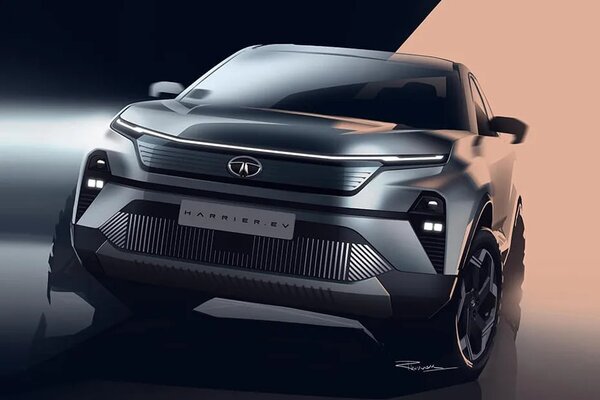What does it take to style new-age Tata cars? Design boss Martin Uhlarik reveals
- Designing a new-age car on the outside and from within is an intricate art that is balanced on several crucial factors.


The days of the Indica and Manza have long been confined to pages of nostalgia as Tata Motors pushes the envelop in terms of not just how its cars perform and the safety on offer but in terms of sheer styling as well. One of the fundamental pillars on which the fate of new-age cars is balanced upon, the styling - exterior as well as from within - is the conversation starter that then leads into all other aspects of the product. Does this make Martin Uhlarik's job far more challenging than in years gone by?
Tata Motors' offerings at present play the design card as doggedly as it focuses on several other crucial aspects that go on to make a car a success. For Uhlarik, Global Design Head at Tata Motors, the challenges are galore but so are the opportunities. The likes of Harrier and Safari are designed to be masculine and aggressive but there is also the sporty Altroz and the simplistic Tiago and Tigor. One suit fits all is just not going to cut it in an ever evolving market.
Also check these Cars
A diverse global customer base has a profound impact on how products are eventually completed, both in terms of visual aesthetics as well as practicality. “Traditionally, you would focus on the first read - exterior, interior. Secondary areas would not be designed, for example, seat-belt or inside of a trunk would be after-thoughts. Now, even the inside of the trunk is designed for maximum utilization. Every little detail, even lights, are now designed," Uhlarik tells HT Auto. “Design is communicating perceived quality and that it is a high tech product. Customers are now very sophisticated and liberated. Not just in automotive space but for any other product, there is a lot of attention to detail."
And in all of this - and despite a diverse customer base, it is absolutely critical to have a product that has a global appeal. “We have design studios in the UK and Italy and Pune as well, and we have a cosmopolitan team so whenever we design a product, we think this product should be able to sell anywhere in the world," Uhlarik highlights. “Indian customers are as attuned to nuances as any other customer whether it's Europe, North America or China."
Staying ahead of and with the Curvv
The changing preferences in body styles and needs of various powertrain options also have an impact on the way a new-age vehicle is designed. Take the particular case of the upcoming Tata Curvv which will speculatively be called Frest upon launch. Showcased first in concept electric form and then in its internal combustion engine (ICE) avataar, this premium crossover SUV is scheduled for a launch in India in 2024. And Uhlarik points to some very interesting takeaways. “What you will see (in the production version of the Curvv) will be very much what we've already shown," he says, adding that there will be subtle visual differences on the outside between the electric and ICE versions. "The difference is really on the front end - upper grille and little bit of the lower end.
Also watch: Tata Curvv Concept electric vehicle: First Look
The Curvv has been spotted on test runs in India in recent times and Uhlarik says that all the design-related work is already complete. “Right now, we're really focusing on the quality, there's a lot of lead up in getting a car industrialised and ready to manufacture, and also making sure that the fit and finish and the overall quality of the product is as high as possible."
The mantra of Avinya


Curvv is but just one exercise in the flexing of design acumen. Tata Motors had also previously showcased the Avinya all-electric concept and this is where Uhlarik's team has had a free run of sorts. After all, designing an electric-only car would be a wholly different exercise, right? “Right, designing an electric car is very different from designing a car with a combustion engine," says Uhlarik. “First of all, the driving spirits is very different as you know. You don't have gear changing, you don't have resistance, so it's a very different dynamically and that should be reflected in the product."


So while the first and second gen EVs from Tata Motors also have ICE twins, the focus is also on gen-three or pure EVs. This is where Avinya - derived from a Sanakrit word meaning 'Innovation' - steps in for play. “When we were designing the Avinya, we moved the wheels outward as we did not have the ICE version. We wanted to maximize the interior space. Aerodynamics also play a huge role in designing an EV because the key word is efficiency. There's range and weight. You have to take down weight without compromising on essentials, and visual language reflects that," Uhlarik says. “The you have to look at it from driving point of view, again efficiency - how long can you drive a vehicle, where do you charge it - it is a whole ecosystem. Designing a pure EV is a completely new ballgame."
A tale of challenges and opportunities in a sustainable world
For all the talks of design though, Tata Motors says it remains firmly committed to its sustainable goals and the objective of offering safe products to customers. And contrary to possible perception, Uhlarik says his work with the design isn't cut to size because of factors like safety needs and sustainable goals. “I feel the tighter the envelope, the more creative the designers become to work around those parameters."








 56.5kWh
56.5kWh 500 km
500 km
 1198 cc
1198 cc Petrol
Petrol


















